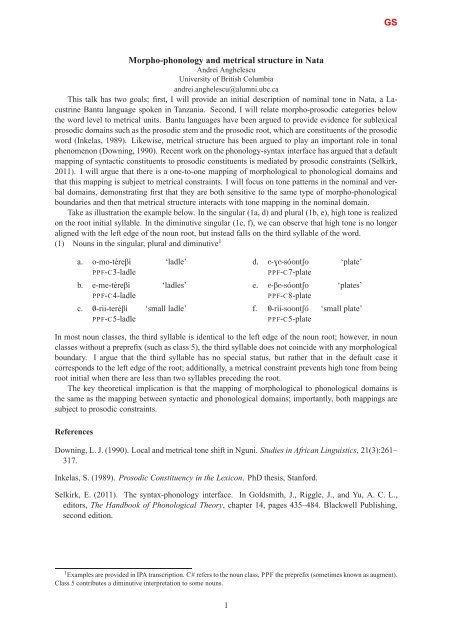here - 5th International Conference on Bantu Languages
here - 5th International Conference on Bantu Languages
here - 5th International Conference on Bantu Languages
You also want an ePaper? Increase the reach of your titles
YUMPU automatically turns print PDFs into web optimized ePapers that Google loves.
Morpho-ph<strong>on</strong>ology and metrical structure in Nata<br />
Andrei Anghelescu<br />
University of British Columbia<br />
andrei.anghelescu@alumni.ubc.ca<br />
This talk has two goals; first, I will provide an initial descripti<strong>on</strong> of nominal t<strong>on</strong>e in Nata, a Lacustrine<br />
<strong>Bantu</strong> language spoken in Tanzania. Sec<strong>on</strong>d, I will relate morpho-prosodic categories below<br />
the word level to metrical units. <strong>Bantu</strong> languages have been argued to provide evidence for sublexical<br />
prosodic domains such as the prosodic stem and the prosodic root, which are c<strong>on</strong>stituents of the prosodic<br />
word (Inkelas, 1989). Likewise, metrical structure has been argued to play an important role in t<strong>on</strong>al<br />
phenomen<strong>on</strong> (Downing, 1990). Recent work <strong>on</strong> the ph<strong>on</strong>ology-syntax interface has argued that a default<br />
mapping of syntactic c<strong>on</strong>stituents to prosodic c<strong>on</strong>stituents is mediated by prosodic c<strong>on</strong>straints (Selkirk,<br />
2011). I will argue that t<str<strong>on</strong>g>here</str<strong>on</strong>g> is a <strong>on</strong>e-to-<strong>on</strong>e mapping of morphological to ph<strong>on</strong>ological domains and<br />
that this mapping is subject to metrical c<strong>on</strong>straints. I will focus <strong>on</strong> t<strong>on</strong>e patterns in the nominal and verbal<br />
domains, dem<strong>on</strong>strating first that they are both sensitive to the same type of morpho-ph<strong>on</strong>ological<br />
boundaries and then that metrical structure interacts with t<strong>on</strong>e mapping in the nominal domain.<br />
Take as illustrati<strong>on</strong> the example below. In the singular (1a, d) and plural (1b, e), high t<strong>on</strong>e is realized<br />
<strong>on</strong> the root initial syllable. In the diminutive singular (1c, f), we can observe that high t<strong>on</strong>e is no l<strong>on</strong>ger<br />
aligned with the left edge of the noun root, but instead falls <strong>on</strong> the third syllable of the word.<br />
(1) Nouns in the singular, plural and diminutive 1<br />
a. o-mo-téreBi ‘ladle’<br />
PPF-C3-ladle<br />
b. e-me-téreBi ‘ladles’<br />
PPF-C4-ladle<br />
c. /0-rii-teréBi ‘small ladle’<br />
PPF-C5-ladle<br />
d. e-Ge-só<strong>on</strong>tSo ‘plate’<br />
PPF-C7-plate<br />
e. e-Be-só<strong>on</strong>tSo ‘plates’<br />
PPF-C8-plate<br />
f. /0-rii-so<strong>on</strong>tSó ‘small plate’<br />
PPF-C5-plate<br />
In most noun classes, the third syllable is identical to the left edge of the noun root; however, in noun<br />
classes without a preprefix (such as class 5), the third syllable does not coincide with any morphological<br />
boundary. I argue that the third syllable has no special status, but rather that in the default case it<br />
corresp<strong>on</strong>ds to the left edge of the root; additi<strong>on</strong>ally, a metrical c<strong>on</strong>straint prevents high t<strong>on</strong>e from being<br />
root initial when t<str<strong>on</strong>g>here</str<strong>on</strong>g> are less than two syllables preceding the root.<br />
The key theoretical implicati<strong>on</strong> is that the mapping of morphological to ph<strong>on</strong>ological domains is<br />
the same as the mapping between syntactic and ph<strong>on</strong>ological domains; importantly, both mappings are<br />
subject to prosodic c<strong>on</strong>straints.<br />
References<br />
Downing, L. J. (1990). Local and metrical t<strong>on</strong>e shift in Nguni. Studies in African Linguistics, 21(3):261–<br />
317.<br />
Inkelas, S. (1989). Prosodic C<strong>on</strong>stituency in the Lexic<strong>on</strong>. PhD thesis, Stanford.<br />
Selkirk, E. (2011). The syntax-ph<strong>on</strong>ology interface. In Goldsmith, J., Riggle, J., and Yu, A. C. L.,<br />
editors, The Handbook of Ph<strong>on</strong>ological Theory, chapter 14, pages 435–484. Blackwell Publishing,<br />
sec<strong>on</strong>d editi<strong>on</strong>.<br />
1 Examples are provided in IPA transcripti<strong>on</strong>. C# refers to the noun class, PPF the preprefix (sometimes known as augment).<br />
Class 5 c<strong>on</strong>tributes a diminutive interpretati<strong>on</strong> to some nouns.<br />
1<br />
GS


